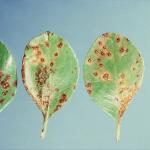Hawthorn Leaf Spot
The fungus Entomosporium mespili (asexual stage) [sexual stage: Diplocarpon mespili] causes hawthorn leaf spot.
Host Plants
Hawthorn leaf spot affects Crataegus laevigata (especially, 'Paulii' English hawthorn) severely.
Description
Initially numerous small red-purple spots develop on infected leaves, green twigs and fruit. Several weeks after infection the often coalesce into purplish-gray-brown blotches. By mid-summer the leaves turn prematurely yellow and drop from severely infected trees.
Disease Cycle
Hawthorn leaf spot survives the winter in lesions on green twigs and fallen leaves. In the spring, rainfall splashes spores from fruiting structures onto developing leaves. Cool rainy conditions maintain leaf wetness and favor spore germination and penetration of leaves and green shoots. Fruiting structures arise in leaf spots and repeating cycles of spore production occur throughout the spring and summer.
Management Strategies
Collect fallen leaves to reduce the amount of inoculum available to initiate subsequent spring infections. Prune and space trees well to increase air circulation and sunlight penetration so foliage dries quickly. If irrigating the trees avoid wetting the foliage and water early in the day so leaves dry rapidly in the afternoon. Where hawthorn leaf spot is a persistent problem, grow resistant hawthorn species such as Crataegus crusgalli (cockspur hawthorn) and Crataegus phaenopyrum (Washington hawthorn). Fungicides protect developing leaves and twigs in the spring on susceptible high value trees. Begin applications when buds break open and repeat at labeled intervals as long as the weather is cool and wet.
Written by: Dan Gillman
Revised: 09/2011
Photo: R. K. Jones, Diseases of Woody Ornamentals and Trees. APS Press.
